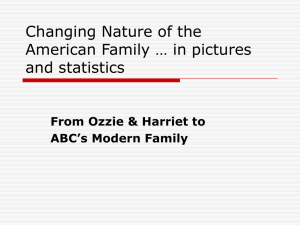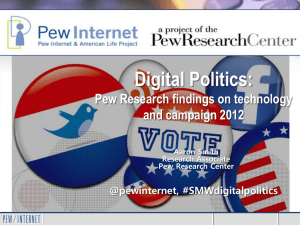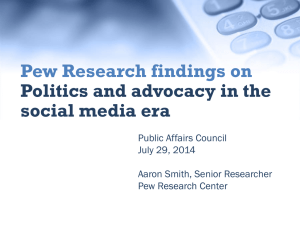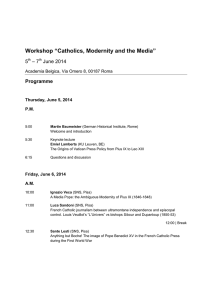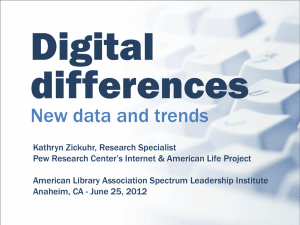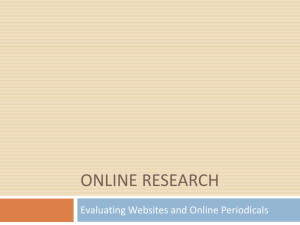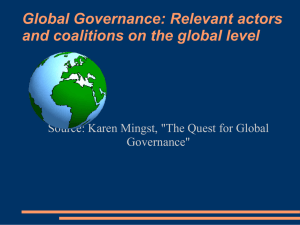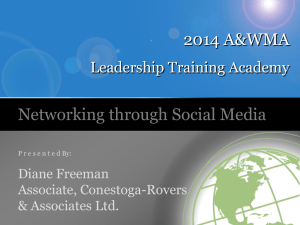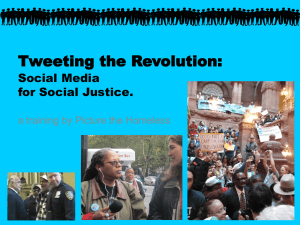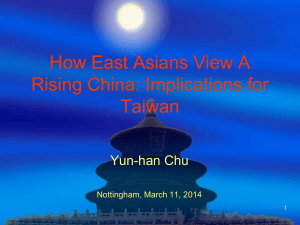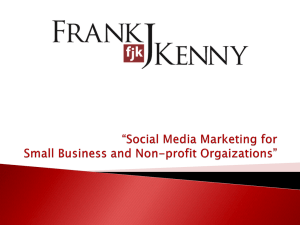Use of Social Media - Pew Internet & American Life Project
advertisement
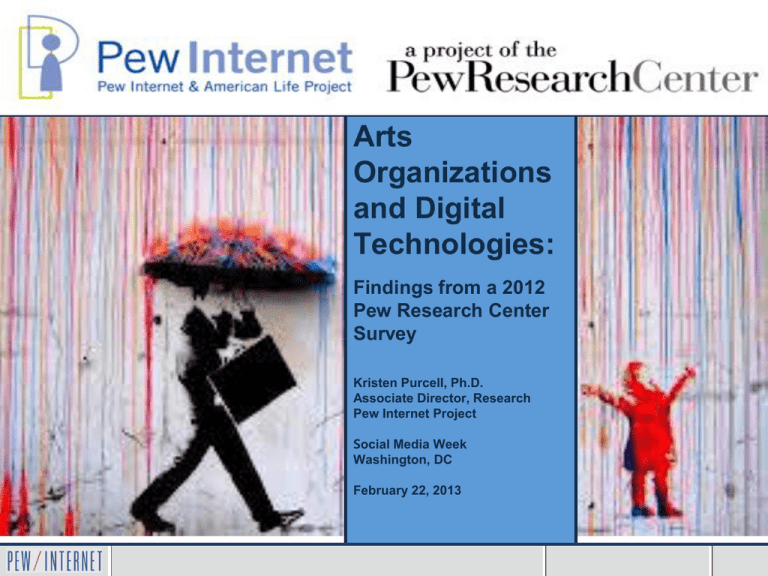
Arts Organizations and Digital Technologies: Findings from a 2012 Pew Research Center Survey Kristen Purcell, Ph.D. Associate Director, Research Pew Internet Project Social Media Week Washington, DC February 22, 2013 About the Survey • Conducted by the Pew Research Center – our mission is to provide high quality, objective data to thought leaders and policymakers • Between May 30 and July 20, 2012, Pew Internet conducted an online survey of a non-probability national (U.S.) sample of arts organizations • 1,258 arts organizations took the survey, representing a wide range of disciplines, organizational functions, budgets, etc. • Art museums comprised 9% of the final sample (performing groups made up the largest portion of the final sample at 22%) • Presentation slides and full report are available at pewinternet.org Setting the Stage: US Adult Internet Use in 2013 85% of US adults use the internet 2/3 have broadband at home 84% have a cell phone, including 45% who have a smartphone 24% have a tablet computer 19% have an e-reader 2/3 of adult cell phone users are wireless internet users 69% of online adults use social networking sites, 16% use Twitter Mobile is the needle, social is the thread Setting the Stage: US Teen Internet Use in 2013 95% of 12-17 year-olds use the internet 77% have a cell phone, including 23% who have a smartphone 31% of 14-17 year-olds have a smartphone 75% of teens text and the median number of texts sent daily is 60 (100 for girls ages 14-17) In July 2011, 80% of online teens used SNS, 14% used Twitter Mobile is the needle, social is the thread Information is Woven Into Our Lives Mobile is the needle, Social Networks are the thread Mobile… Social Networks… Moves information with us Surround us with information through our many connections Makes information accessible ANYTIME and ANYWHERE Bring us information from multiple, varied sources Puts information at our fingertips, literally Provide instant feedback, meaning and context Magnifies the demand for timely, actionable information Allow us to shape and create information ourselves and easily Makes information location-sensitive amplify others’ messages How your patrons reflect these mobile/social trends… % of all adults who have used a handheld device (phone/e-reader/tablet) to… View or download visual arts content 16% Watch or download a music, dance or theater performance 15% View or download info/images from a historic site, park or monument 12% Download or listen to audio tour at a museum, gallery or historical site View/download info or images from a museum 8% 6% 2011 data 74% of adult smartphone owners use their phone to get directions, recommendations or other information based on their present location 21% use their phone to get coupons or deals to use at local businesses Patrons develop personal connections via SNS with public figures and entities… % of adult SNS/Twitter users who follow… Individual artists, musicians or other performers 41% Musical, dance or theater groups/venues Arts galleries or other visual arts orgs 29% 11% 2011 data Museums 8% …and those personal connections can help you find and engage with “Superfans” In the 12 months prior to the survey…. 44% of adults had attended a live music, dance or theater performance – it was 77% among those who follow a music/dance/theatrical group or venue on SNS 35% of adults had visited a museum – it was 82% among those who follow a museum on SNS 35% of adults had attended an arts, craft or music festival – it was 55% among those who follow individual artists, musicians or performers on SNS 29% of adults had visited an art gallery, show or exhibit – it was 82% among those who follow an art gallery or other visual arts organization on SNS 2011 data So, how are arts organizations capitalizing on these trends? Generally increasing their online presence % of arts orgs who say the internet is very or somewhat important for… Very Important Somewhat Important Promoting the arts 81% 15% Increasing audience engagement 78% 18% Gathering research and data for grant applications 65% 25% Indentifying sources of funding 64% 27% Using your organization's resources more efficiently 63% 29% Engaging in arts advocacy 55% Providing arts education to the public Artistic creation and/or collaboration 28% Improving arts cataloging and collections management 27% Improving arts curation 19% 0% 37% 39% 16% 24% 20% 40% 60% 80% • 86% have increased the number of online events and exhibits they host over the past several years • 97% have a social media presence 29% 33% • 99% host a website 100% Source: Pew Research Center’s Internet & American Life Project Arts Organizations Survey. Conducted between May 30-July 20, 2012. N for respondents who answered this question=1,212. • 69% have individual employees with professional social media profiles they use in their capacity as a representative of the organization Major functions served by arts orgs’ websites Multi-Media Content Promotion • 94% post photos on their website • 86% accept donations online • 81% post or stream video • 74% maintain an online calendar • 57% post or stream audio • 72% sell tickets online • 50% maintain a blog • 47% sell merchandise online • 20% present online exhibits • 34% make info available through RSS feeds • 31% offer discounts through services such as Groupon or LivingSocial Audience Interaction • 90% let patrons share their content via email, SNS and Twitter • 81% let users comment publicly on the site • 28% host online discussion groups • 22% host webinars Arts Orgs’ Use of Social Media The social media platforms arts organizations use… • 97% of these orgs have a profile or page on a social media site • 69% also have individual employees with professional social media profiles they use as representatives of the organization • 56% of the orgs that use social media have a profile on 4-9 different social media sites Source: Pew Research Center’s Internet & American Life Project Arts Organizations Survey. Conducted between May 30-July 20, 2012. N for respondents who answered this question=1,202. • 10% of the orgs that use social media are active on 10+ platforms How 45% of arts orgs using social media post daily How often organizations post content on social media… Every few weeks 8% Less often 3% About once a week 16% Several times a week 28% Several times a day 25% About once a day 20% Source: Pew Research Center’s Internet & American Life Project Arts Organizations Survey. Conducted between May 30-July 20, 2012. N for respondents who answered this question=1,131. Other uses of social media… • 82% use social media to engage with audience members prior to, during, or following an event • 77% use social media to monitor what is being said about their organization • 65% use social media to learn more about their audience • 52% use social media to get feedback from the public or “crowdsource” an idea Do arts orgs see a payoff from social media? • 56% say it’s had a major impact on boosting org’s public profile • 53% see major impact on engagement with public • 48% see major impact on increasing traffic to website • 45% see major impact on event promotion/attendance • 41% see major impact on audience building and stakeholder engagement • 27% see major impact on audience engagement w/content • Just 13% see major impact on professional collaboration, or on fundraising Very true Somewhat true Social media is worth the time our organization spends on it 58% Social media helps my organization reach a broader audience than it would otherwise be able to 33% 52% The younger employees in our organization have a more positive view of social… Social media helps our existing audience members feel more a part of the organization 41% 38% 32% 37% Overall, my organization does not have the personnel or resources it needs to use social media… Social media creates more risks than benefits for our organization 48% 30% 44% 5% 0% 20% 40% 60% 80% 100% Source: Pew Research Center’s Internet & American Life Project Arts Organizations Survey. Conducted between May 30-July 20, 2012. N for respondents who answered this question=1,117. Not everyone is on board the social media train Major reason Minor reason My organization is concerned about the continued resources that would be necessary to maintain a successful social media profile or campaign 35% My organization does not have the staff skills or knowledge it needs to begin using social media 30% My organization is able to reach our community/ stakeholders through other means, so we do not need to use social media 25% 18% My organization does not have the financial resources it needs to begin using social media 39% 16% My organization does not use social media because it is too difficult to control what is said in social networking spaces My organization does not have access to the updated hardware or software necessary to use social media effectively 40% 33% 12% 7% 40% 23% My organization tried using social media in the past and found that it was ineffective 5% 5% 0% 20% 40% 60% 80% Source: Pew Research Center’s Internet & American Life Project Arts Orgs Survey. Conducted May 30-July 20, 2012. N for respondents who answered this question=1,117. Funding and Staffing Social Media Efforts Staffing Funding and Development • 76% of social media-using orgs have full-time paid staff tending the sites • 49% of these orgs have sought funding specifically to expand their organization’s use of the internet or other technologies, such as apps and social media • 29% use part-time staff • 16% use volunteers • 8% use paid contractors • Altogether, 13% use a combination of full-time and part-time staffers to manage social media • Just 27% have a staff member whose position is dedicated to social media management • 73% use staff to oversee social media who also have other responsibilities • 36% have conducted research to learn more about how their audiences use technologies Social media, the good…. “When SB1079 passed in Arizona, our organization (who specializes in Mexican music and dance), in the matter of days, was able to write, record and make a video of a song that directly addressed the issue. The video was posted on YouTube and got hundreds of hits in the matter of days. It was a way for us to execute our mission to a large audience in a short amount of time.” “After seeing that a patron has checked into our venue or has been talking about how good our show was, we thank them publicly and invite them back. This gives us the ability to create a personal interaction with them and create a connection that encourages them to come back. Sometimes our actors will join in when they see us thanking a patron, and send a personal thanks from the cast. “ “We were the subject of comments concerning funding and donations from a local political organization and our patrons responded in full with comments, examples and telling our story in a stronger and better way than even our staff would have been able to do. We were proud that we did not have to, in any way, defend our value to the community, our audience did this for us.” “We solicited ideas for how to name our "signature cocktail" at an upcoming benefit, based on the theme of the benefit. Facebook fans wrote in with lots of ideas, we picked our top favorites, and then released a poll so fans could vote on the name we ended up using. It generated awareness of the event (which was a record success) and allowed those who might not have been able to attend the event a way to engage with the party.” ….and the bad “Any time you engage in social media, you open yourself up to negative feedback. An example of this would be announcing our summer concert series, and having someone not like one of the many guest artists we bring in. However, for every negative comment, there is usually someone with a different opinion.” “We provide grants and an organization who was unhappy about not receiving a grant posted some negative stuff on Twitter. While we responded and kept it professional, it did put negative comments out there associated with our profile, potentially damaging our brand.” “Because we do a lot of work in rural areas, with senior citizens, and low income areas, social media only works for a portion of our audience. Getting everyone informed of a last minute change or spontaneous program simultaneously is tricky without overlooking certain portions of the population. A heavy reliance on social media, though convenient, can exclude many people.” “Before we put policies in place, one of our employees, who was a great social media user, kind of merged his own identity on Facebook with that of our organization. Therefore, when he also would party and post about it – it became an area of discipline. And he didn't understand the need for separating these things out, keeping his personal life off of our public profile. That was several years ago.” Broader impacts on the arts world… Perceived positive impacts of technology on the arts Based on your experiences and those of your organization, do you agree or disagree with each of the following statements? Strongly agree Somewhat agree The internet has increased engagement in the arts by providing a public platform through which more people can share their work 50% Because of the internet and digital technologies, the arts audience is more diverse than it was in the past 42% 31% The internet has played a major role in broadening the boundaries of what is considered art 52% 27% 0% 20% 50% 40% 60% 80% Source: Pew Research Center’s Internet & American Life Project. Conducted May 30-July 20, 2012. N for respondents who answered this question=1,207. 100% Broader impacts on the arts world… Perceived negative impacts of technology on the arts Strongly agree Digital distractions such as ringing cell phones and audience member texting are a significant disruption to live performances 37% The internet and related technologies have created an expectation among some audiences that all digital content should be free The internet and digital technologies are negatively impacting audience members' attention spans for live performance The internet is shifting the focus of many arts organizations from artistic creation and curation to promotion and marketing 34% 26% 9% 48% 31% 6% The internet and digital technologies are hurting arts organizations by decreasing attendance at in-person 3% events Somewhat agree 29% 19% The internet and digital technologies are diluting the arts by giving everyone interested in the arts and arts 2% 8% criticism a public platform 0% 20% 40% 60% 80% Source: Pew Research Center’s Internet & American Life Project. Conducted between May 30-July 20, 2012. N for respondents who answered this question=1,207. What does the future hold? “As the realism of participatory digital entertainment (video games, etc.) and the immersion ability of non-participatory digital entertainment (3D movies, etc.) increases, it threatens the elements that make the live arts unique--the sense of immediacy, immersion, and personal interaction with the art. We've long hung fast to the belief that there's nothing like a live experience, but digital entertainment is getting closer and closer to replicating that experience, and live theatre will struggle to compete with the former's convenience and cost.” “Digital technologies allows for students and artists all over the world to be inspired by one another. In some ways this is fantastic, in other ways, this breaks down the cultural differences that is so beautiful about having multiple countries involved in an art form.” “Our chief concern for the literary arts is the increasing "validity" of self-publication among reviewers, readers, and writers. Online publishing and book sales through Amazon (for example) contribute to this problem. If there are no gatekeepers, it will become even more difficult to draw attention to works of genuinely high quality.” “Access will be good for educational purposes and to increase awareness of the arts especially historical material in performance of all types. However, issues of copyright and payment for that material, such as in apps and in streaming or downloading, are murky and hard to navigate for artists themselves as to value and fairness of payments to the artist for original content. “ THANK YOU!! Data and report available at: pewinternet.org Kristen Purcell Associate Director for Research, Pew Internet Project kpurcell@pewinternet.org Twitter: @pewinternet @kristenpurcell ***Cover and background image is street art in Norway by Skurktur***
